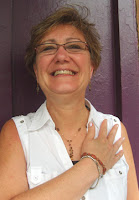 |
| Rings, Bracelets, Earrings, Necklaces by Manya Vee Selects artists |
Jewelry. According to Wikipedia,
jewelry has no other purpose than to look appealing. Well, we here
at
Manya Vee Selects take issue with that! To us, jewelry is a way
each and every one of us can share a little piece of beauty with the
world around us as we walk through our day. It makes not only you
feel a bit more beautiful yourself, but also brings delight and
enjoyment to friends and complete strangers.
 |
Here she is, sporting her
new garnet necklace, earrings
and bracelet! |
The oldest-known jewelry is over
100,000 years old, made of Nassarius shells. (How many of you had a
puka shell necklace at some point in your life?) Since then, people
have been making jewelry out of all kinds of materials, including
metals, stones, glass, bone, feathers, and whatever else they can get
their hands on.
 |
| Puka Shell Necklace |
I love that the derivation of the word
“jewelry” comes from the Latin “jocale”, meaning plaything!
I often see people playing with their jewelry: twisting a ring, or
moving a pendant along its chain. It's a fun aspect to life indeed.
But throughout history, jewelry has taken on a number of purposes,
including currency or wealth display, function - as in clasps or
fasteners, symbolism - to show membership or status, protection - in
the form of an amulet or talisman, or simply artistic display.
When I was hiking in the Himalayas, in passing through a village, you could always tell which woman was the chieftan's wife because of the ostentatious array of turquoise, coral and amber jewelry she'd be wearing.
Interestingly, function and wealth have
been the main roles of jewelry. Although making those look beautiful
has always been part of it, it has played a secondary role. Until
the 19th century, that is. In the late 19th century, jewelry masters
Peter Carl Faberge and Rene Lalique emphasized the artistic qualities
that jewelry could embody.
 |
| Brooch by Lalique |
That trend has continued until today,
with many thinking of jewelry in terms of miniature sculpture.
Alexander Calder influenced many of the jewelers at Manya Vee
Selects, including Manya herself. Also a sculptor, Calder reduced
the scale of sculpture to jewelry size, and made a name for himself
as an innovator in terms of style as well as materials used. He
often used materials viewed as non-precious including pottery shards
and woven cording, and less-precious metals like brass and copper.
 |
| Calder Necklace of brass |
The late-20th century has seen the
emergence of a strong art jewelry movement, defined specially as
jewelry designed to promote a concept. The concept is more important
than the materials used. It might be a plastic-coated photograph,
encased in an acrylic frame hanging on a cotton cord, as opposed to
diamonds and gold. The content of the photograph and the way it is
presented are what provide the value here, as opposed to the
intrinsic value of gold and diamonds.
 |
Photo encased in resin
on metal |
The Pacific Northwest has a very strong
group of art jewelers who are known on an international scale.
Instrumental in paving the way for this was the now-deceased Ramona
Solberg, whose work was clearly influenced by Calder. Ms. Solberg
was a fine artist, as well as a teacher and mentor. Under her
tutelage, strong jewelry programs arose at various community colleges
and even high schools. The Seattle Metals Guild counts among its
members many of these intriguing jewelry artists.
 |
| Solberg fibula brooch |
Judy Morgan of J Heather Designs is
among the Manya Vee Selects jewelers who says she is influenced by
Calder. Even more so, however, she is influenced by the universe and
its myriad stars, constellations, comets and other wonders. Her
newest jewelry collection incorporates blackened sterling silver,
18-karat gold, raw stones and pearls to great effect. Price range:
$125 - $285.
 |
| Pendant by Judy Morgan |
 |
Hickman earrings, inspired
by Calder |
Emily Hickman is another Manya Vee
Selects jeweler who loves Calder. She's currently developing an
entire collection devoted to his influence. This pair of earrings is
a great example. Price range: $22 - $225.
 |
Parrott necklace, inspired by
the way leaves and fruit
hang off vines |
Cheryl Parrott fits into the art
jewelry category by her use of glass beads and copper-coated wire
that looks like antiqued brass. Cheryl studies the way fruit and
leaves hang off vines, and tries to capture that in her jewelry.
Notice how it is assymetrical, yet balanced. Price range: $28 - $150.
 |
Three rings by Bill Booze:
Amethyst, Tourmaline,
London Blue Topaz |
I can't help but be fond of colorful,
sparkly stones. Bill Booze buys his stones raw and facets them
himself, using only the most amazing and high quality stones
available. He sets them himself, often in sterling silver to keep
the costs within a more reasonable level. Simple settings make the
stone itself stand out. Priced from $300 - $1200.
 |
Fused, Forged and Woven
from Manya Vee's new collection |
I myself have been influenced by a number of
factors over the past year, which is culminating in an entirely new
and completely different line of jewelry for me. Rounded shapes like
circles, ovals and teardrops are forged out of fine silver. Then, I
weave a very fine 14k gold-fill wire around the frame. Finally, a
single, wrapped stone is added at the bottom. Prices range from $48
to $138.
Whatever your reasons are for wearing jewelry, we hope you'll enjoy the wide variety of jewelry offered by over 25 jewelry artists at Manya Vee Selects!
Artfully Yours,
Manya Vee
www.ManyaVeeSelects.com













































